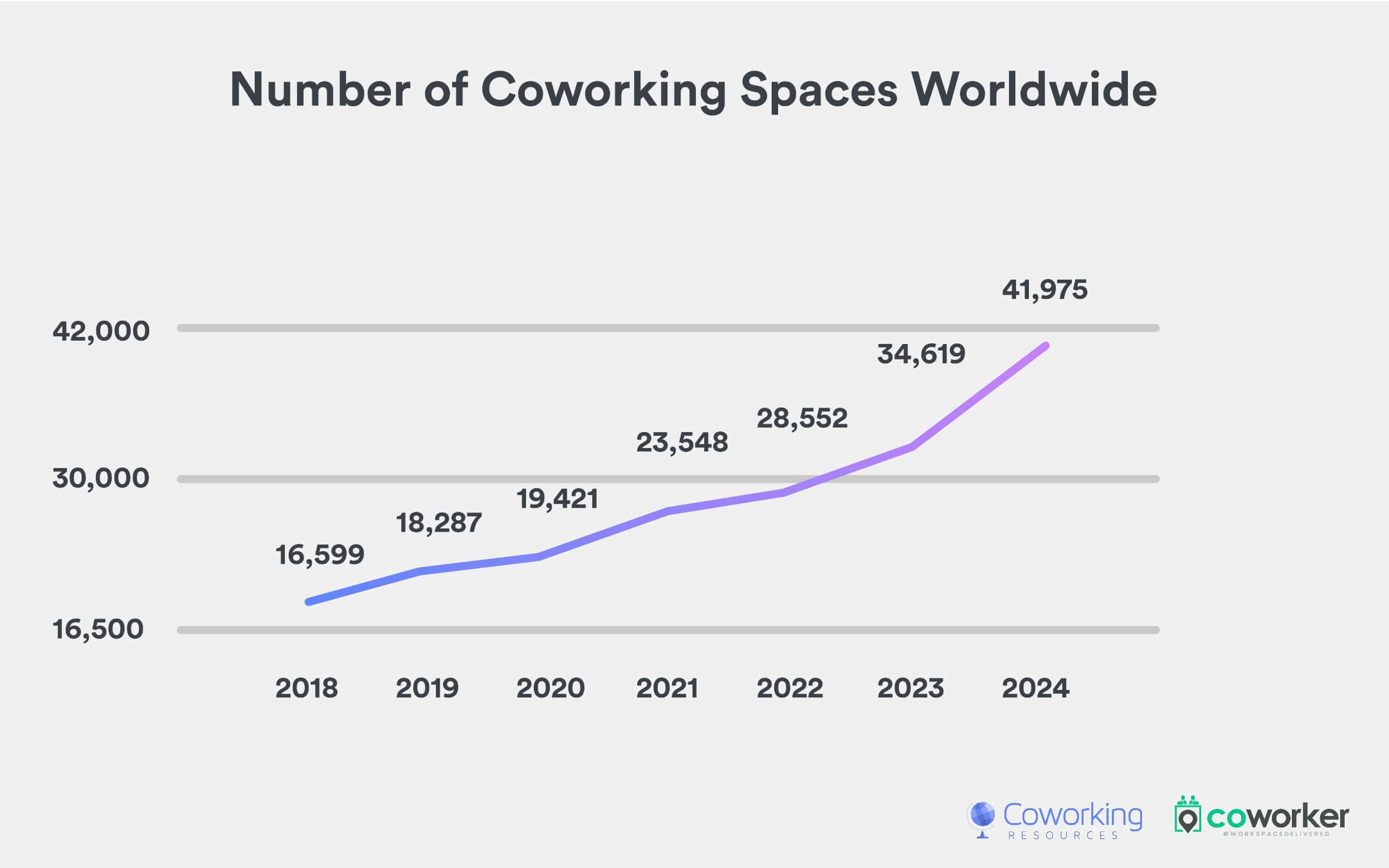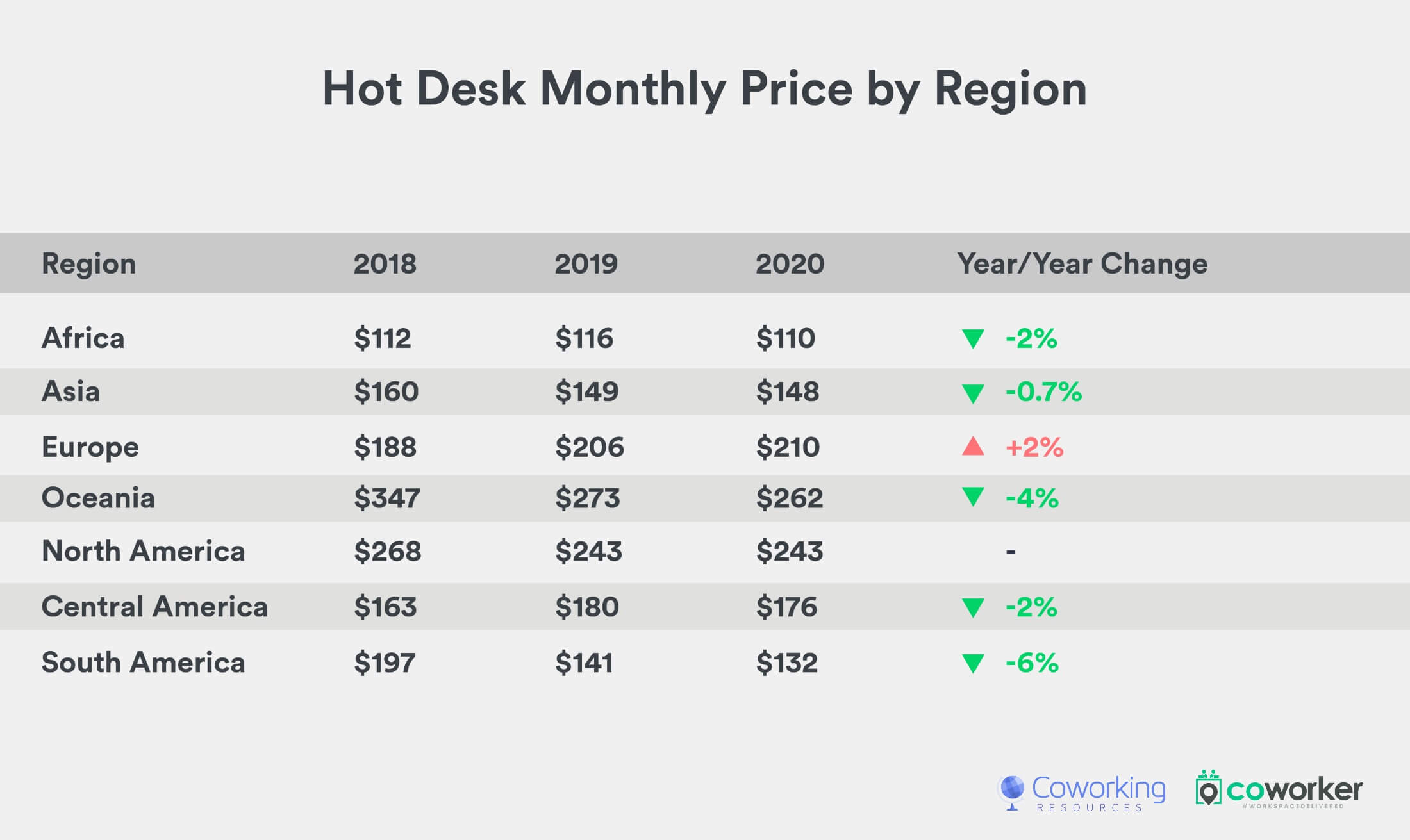
Largest Coworking Companies


At CoworkingResources we aim to provide the most comprehensive guides and materials about the coworking industry in order to help owners and operators run more efficient spaces. Last year’s study is now one of the most cited ones in the industry, and this year we are happy to introduce an even more comprehensive analysis of where the industry is headed. To achieve that, we have partnered with Coworker.com, the world’s largest coworking listing platform, for our 2020 Global Coworking Growth Study.
This study explores the projected growth of the coworking industry as well as specific trends, providing you with a bird’s-eye view of how the industry is developing across the world.
The number of coworking spaces worldwide is projected to reach almost 20,000 this year and cross over 40,000 by 2024. While the industry is set to grow at a slower pace in 2020, we expect growth to rebound and develop even more rapidly from 2021 onwards, with a yearly growth rate of 21.3%.

We estimate that almost 5 million people will be working from coworking spaces by 2024, an increase of 158% compared to 2020.

These projections reflect not only the growth that the industry has experienced over the past few years, but also the dramatic increase in flexible and remote work practices adopted by businesses worldwide.
While in 2020 the coworking market is forecasted to grow at around half the rate as the previous two years, the overall outlook for 2021 and onwards is extremely positive, and so were coworking operators’ sentiments before Covid-19.
Based on data from the 2019 Coworker Member’s Choice Awards, before the coronavirus hit the world economy around 77% of the coworking operators surveyed said they plan to expand by opening new locations.

32% of operators said they planned to open one new location by 2020, and 38% said they plan to open 2-3 new locations.
What might be even more interesting is the forecasted growth of larger companies, given that almost 9% of respondents said they plan to open 8+ new locations by the end of 2020. This signals that many multi-location spaces are turning into small chains that serve entire regions.
Of the respondents, 52.03% of respondents operate one total location under the umbrella of their brand, while 28.61% operate two-three total locations, and 12.62% operate 8 or more.
According to Coworker’s Coworking Size & Capacity Report, Asia is the continent with the highest average capacity of 114 people, compared to spaces in South America which held the lowest average capacity of 54 people. Within Asia, China ranked as the country with the largest capacity, with a whopping 282 people on average per space, which is more than twice the average capacity of spaces in the U.S. - which is 105 people.

In terms of space size though, North America has the largest spaces in the world, with an average size of 9,799 sq.ft. per space, followed by Asia at 8,101 sq.ft., while smaller spaces are more commonly found in Europe and South America.
As more corporate companies embrace flexible work practices, we can expect capacity to continue to grow overtime as serviced offices and remote teams will become increasingly important for space operators.
According to a survey conducted in May 2020, 56% of professionals in the U.S. expect to work remotely at least part time, and around 29% expect to work remotely on a full time basis. Such insights reflect not only how work practices are changing for individuals, but also how businesses are embracing working with small remote teams regardless of their location.

The United States is still leading as the biggest market with over 3,700 shared workspaces across the country, followed by India (2,197 spaces) and the United Kingdom (1,044 spaces). In terms of yearly growth in 2020, out of the largest markets, Germany and India are the two fastest-growing, followed by the United States and Canada.
The chart below shows the 20 largest markets by number of coworking spaces and the corresponding share over all spaces worldwide.

The global average price per desk dropped by 2.14% between 2019 and 2020, which illustrates the increasing supply of new flexible offices, as well as how higher competition is leading to even more affordable options for companies and professionals.

As the coworking industry goes mainstream, the downward trend in prices is reflected across different regions in the world. The only exception is Europe, where prices have increased by almost 12% over the past 2 years.

Based on Coworker listings, the top 15 cities with the most expensive average monthly hot desk prices include 8 American cities and 6 European cities.

When comparing the world’s most expensive cities for coworking, Palo Alto in California claimed the top spot in 2019-2020, with monthly hot desk prices of $511 on average. Zurich came in second place at $456 per month, with Santa Monica claiming third place at $404 per month. Interestingly, our data shed light on just how expensive real estate is in California — 8 of the state’s top cities were among the top 25 most expensive cities in the world.
In terms of country rankings, Monaco took the top spot in 2019-2020 for most expensive monthly hot desk price, coming in at $397 per month. Switzerland came in second place at $395 per month, and Malta is third with $347 per month.

After analyzing over 3,000 requests between February 2020 (pre-lockdowns) and May 2020 (post-lockdowns), space utilization is beginning to recover and shift toward private offices (as the type of space most commonly requested), longer-term contract durations, and higher capacities (of desks needed).
Such preliminary data shows:
In a post-COVID-19 world, these statistics make it easy to predict that coworking will become even more mainstream, especially since companies are shifting to remote-first workforces.
Demand will mainly come from larger organizations and enterprises looking to decentralize their workforces into smaller branch offices and remote teams into private flex offices. That demand will be led primarily by private offices, followed by dedicated desks, while hot desks and meeting rooms (for non-members) will take the longest to fully recover.
In the long run, all offices will potentially turn into flexible, on-demand spaces and in spite of the challenges faced by many operators in 2020, the potential for the coworking industry to grow and evolve has never been higher.
The study has been conducted using proprietary data from Coworker, CoworkingResources as well as external research. More information about the methodology applied is available below.
Number of Coworking Space Worldwide: Estimates based on proprietary data about coworking space opening announcements from CoworkingResources for the years 2018, 2019 and 2020. Projections for 2021-2024 are based on average yearly growth of Coworker’s listings as well as Coworking Resources data.
Number of People Using Coworking Spaces Worldwide: 2018 data based on Deskmag's research. 2019-2024 estimates are based on proprietary data from Coworking Resources about coworking space opening announcements, growth forecasts from Coworker’s listings as well as estimates on the seats/request growth based on Coworker data for 2020.
Coworking Size and Capacity: Data from Coworking Insights & Coworker’s 2019 Coworking Size and Capacity report, based on square footage and density from 6,405 coworking spaces in 113 countries.
Geography: Data based on Coworker listings by country and adjusted to the total market size in 2020 as estimated in the chart "Number of Coworking Space Worldwide".
Hot Desk Prices: Data from Coworking Insights & Coworker’s 2020 Desk Price Index report, based on pricing from 12,601 coworking spaces in 158 countries.
Search volume for 'coworking': Data based on worldwide search for the topic "coworking" on Google Trends, for a 5-year period until June 2020.
Post-Covid Predictions: Data based on 3,012 coworking requests collected by Coworker between February 2020 and May 2020.
For press inquiries about this study, you can get in touch at:
All of the report’s charts are available for download at this link.
Save your community manager 41 hours each week—learn how The Yard did it with cloud-based access control.
Read the Case StudyFree access to our best guides, industry insights and more.
